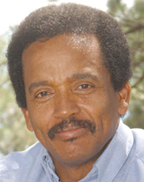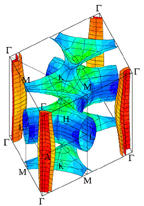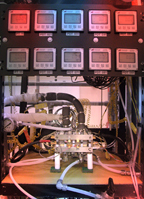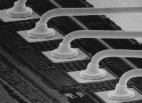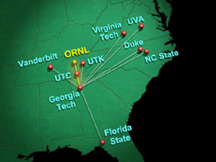| Research
|
|
|||||||||||||||||||||||||
|
Oak Ridge datapipe: Fast as the Wind The new computer link between DOE's Oak Ridge National Laboratory and Atlanta is 200,000 times faster than the fastest dial-up connections typical of home computers and is expected to spur significant advances in science and economic development in the region and beyond.
Ray Orbach, director of the DOE's Office of Science, symbolically completed the connection linking the laboratory's supercomputer to Southern Crossroads universities and other premier schools around the country. The link will connect DOE's ESnet computer network with Internet2, the network of top-tier universities, at speeds up to 20 times faster than the previous ORNL connection. With the new link, a data file the size of the film Gone With the Wind could be transmitted in a mere six seconds. "This new high-speed network strengthens the partnership between DOE and the academic community, which is critical to our plans to reassert U.S. leadership in computational sciences," said ORNL's Thomas Zacharia, associate lab director for the Computing and Computational Sciences Directorate. The network of fiber optic cables, which run from ORNL through Chattanooga to Georgia Tech in Atlanta, also will enhance the ORNL-Chattanooga technology corridor by positioning the region for new research and development opportunities. The benefits are likely to extend far beyond the ORNL-Chattanooga technology corridor and Georgia. The connection to Southern Crossroads universities will allow for vastly increased flow of information between ORNL researchers and collaborators at Internet2 institutions. Southern Crossroads members include the universities of Tennessee, Georgia, Alabama, South Carolina and Kentucky and Florida State, Vanderbilt, and Emory universities along with Georgia Tech, the site of the 10 gigabit (10 billion bits per second) connection. The high-speed link is provided by Qwest Communications International, which also supplies the backbone for ESnet and Internet2. With the link to ORNL's Cheetah, a 4.5 teraflop IBM machine recently listed No. 8 in the Top500 list of fastest computers in the world, researchers from leading universities and national laboratories will have access to incredible amounts of data that will help them in their studies of astrophysics, biology, chemistry, climate modeling, materials and fusion. Researchers will be able to acquire data through ORNL's Center for Computational Sciences in a matter of seconds. "The network forms a test bed that will serve as the basis for network research and development that will carry DOE's computational mission forward for the next five to 10 years," Zacharia said. "Soon, we will need to transport petabyte-size files and this network and the research it enables will be crucial." For example, John Drake, an ORNL senior researcher, noted the immediate impact the high-speed connection will have in ocean science studies and a $20 million SciDAC climate study. "This enables our collaborators at Scripps Institution of Oceanography, the National Center for Atmospheric Research and Los Alamos National Laboratory to receive very large data files containing new analyses of the ocean's influence on future climates," Drake said. "With that information readily available, researchers will be able to perform studies more quickly and they will be able to develop more sophisticated models." Submitted by DOE's Oak Ridge National Laboratory |
